Solve your math problems using our free math solver with stepbystep solutions Our math solver supports basic math, prealgebra, algebra, trigonometry, calculus and moreGet stepbystep solutions from expert tutors as fast as 1530 minutes Your first 5 questions are on us!Click here👆to get an answer to your question ️ If √(1 x^2) √(1 y^2) = a(x y) then prove that dy/dx = √(1 y^2/1 x^2) Join / Login > 12th > Maths > Differential Equations > Formation of Differential Equation 2 1 − x 2 1 (− 2 x) 1 − y 2

Differential Equations Separation Of Variables Ppt Download
X^2(x^2-1)dy/dx x(x^2 1)y=x^2-1
X^2(x^2-1)dy/dx x(x^2 1)y=x^2-1-Simple and best practice solution for (2xy)dx(x^21)dy=0 equation Check how easy it is, and learn it for the future Our solution is simple, and easy to understand, so don`t hesitate to use it as a solution of your homework If it's not what You are looking for type in the equation solver your own equation and let us solve itShare It On Facebook Twitter Email 1 Answer 0 votes answered by paayal (147k points) selected by Vikash Kumar




Separable Differential Equation Dy Dx X Sqrt 1 Y 2 Youtube
Verify that y = log (x √(x^2 a^2)^2 is a solution of the differential equation (a^2 x^2)d^2 y/dx^2 x(dy/dx) = 0 asked May 10 in Differential Equations by Yajna ( 299k points) differential equationsY=0 when x=2 differential equations; y = x^2(1 e^( 1/x1 )) We have dy/dx (12x)/x^2y = 1 and y(1)=0 We can use an integrating factor when we have a First Order Linear nonhomogeneous Ordinary Differential Equation of the form;
Rewrite 2xy dxx2 dy−1 dy = 0 2 x y d x x 2 d y − 1 d y = 0 Change the sides $$2 xy \ dx x^2 \ dy = 1 \ See full answer belowSimple and best practice solution for 3y(x^21)dx(x^38y3x)dy=0 equation Check how easy it is, and learn it for the future Our solution is simple, and easy to understand, so don`t hesitate to use it as a solution of your homework If it's not what You are looking for type in the equation solver your own equation and let us solve itWolfram Alpha gives which looks a lot more likely to me to be correct than the other answer provided so far (which includes a pretty elementary error in the
Calculus Find dy/dx y^22x=12y y2 − 2x = 1 − 2y y 2 2 x = 1 2 y Differentiate both sides of the equation d dx (y2 −2x) = d dx(1 −2y) d d x ( y 2 2 x) = d d x ( 1 2 y) Differentiate the left side of the equation Tap for more steps(a) 3x^2 d^y/dx^2 11x dy/dx 3y = 0 (b) x^2 d^2y/dx^2 x dy/dx 5y = 0 Verify that the function phi(x) = c_1 e^x c_2 e^2x is a solution to the linear equation d^2y/dx^2 dy/dx 2y = 0 for any choice of the constants c_1 and c_2 Determine c_1 and c_2 so that each of the following initial conditions is satisfiedThe issue is that you integrated y with respect to x, and concluded that it was equal to y This is only viable if y = aex for some constant a, which we have no reason to suspect Solve y ^2x (\frac {dy} {dx})^2 = 1 using proposed change of variables Solve y2 −x(dxdy )2 = 1 using proposed change of variables




Example 9 Find General Solution Of Dy Dx X 1 2 Y Examples




Solution 1 Xsqrt X 2 Y 2 Dx Y 1 Sqrt X 2 Y 2 Dy 0 Is X Y
See the answer IIf y = (x 2 1) m, then the (2m) th differential coefficient of y wrtx is If y = {sin (x a)} / {sin (x b)}, a ≠ b, then y is If y = 1 1/x 1/x 2 1/x 3 ∞ with x>1, then dy/dx is equal toPlease Subscribe here, thank you!!!




X 1 Y 2 Dx Y 1 X 2 Dy 0 Youtube




Solve The Differential Equation Dy Dx Xy 2 1 Chegg Com
Homework Statement rewrite the equation in the form of linear equation Then solve it (1x^2)dy/dx xy = 1/ (1x^2) the ans given is y= x/ (1x^2) C / ( sqrt rt (1x^2) ) , my ans is different , which part is wrong ? Solve the following differential equation (1 x 2)dy 2xydx = cotx dx ;Question The differential in term of x and dx y = In (x 2) 1 dx x2 O A dy = 24 O B dy = x dx OCdy = (x 2) dx OD dy dx Х This problem has been solved!




Unit 03 Differential Equations Doc Logical Truth Equations




Solve The Given Differentia By Separation Of Chegg Com
Solve your math problems using our free math solver with stepbystep solutions Our math solver supports basic math, prealgebra, algebra, trigonometry, calculus and moreFind dy/dx y= (x1) (x^21) y = (x 1)(x2 − 1) y = ( x 1) ( x 2 1) Differentiate both sides of the equation d dx (y) = d dx ((x1)(x2 −1)) d d x ( y) = d d x ( ( x 1) ( x 2 1)) The derivative of y y with respect to x x is y' y ′ y' y ′ Differentiate the right side of the equation Tap for more stepsLearn how to solve differential equations problems step by step online Solve the differential equation dx/dy=(x^2y^2)/(1x) Group the terms of the differential equation Move the terms of the x variable to the left side, and the terms of the y variable to the right side Simplify the expression \frac{1x}{x^2}dx Simplify the fraction by x




Solution Solve The Differential Equation X Y 1 Dx X 1 Dy 0 If Y 2 When X 1



How To Get The Special Solution Of This Differential Equation Y Xdy Dx 2 1 X 2 Dy Dx Where X 1 Y 1 Quora
∂F/∂y = x^2 g'(y) = N x^2 g'(y) = 2y x^2 1 g'(y) = 2y 1 Integrating, g(y) = y^2 y C Therefore, F = (x^2)y 3x^3 y^2 y C #2 This is incomplete I can't remember solving the right side (if there is a function of x;Y(q) = r given, p =7, q=3, r=7 Q The new bookcase for your future dorm room has the dimensions of 24 in wide by 12 in deep by 36 in A Width of the bookcase=25 inch Depth of the bookcase=12 inch Transcript Example 10 Find the general solution of the differential equation 𝑑𝑦/𝑑𝑥=(1 𝑦^2)/(1 𝑥^2 ) 𝑑𝑦/𝑑𝑥=(1 𝑦^2)/(1 𝑥^2 ) 𝑑𝑦/(1 𝑦2)=𝑑𝑥/(1 𝑥^2 ) Integrating both sides ∫1 𝑑𝑦/(1 𝑦^2 ) = ∫1 𝑑𝑦/(1 𝑥^2 ) (∫1 1/(1 𝑥^2 ) dx = tan−1 x c) tan−1 y = tan−1 x c tan−1 y = tan−1 x c is the




1 X 2 1 Y Dx X Y 1 Y Dy Y 4 1 X 1 Y Dx Xy 1 Y Dy Youtube



How To Solve The Following Differential Equation 1 X 2 Dy Dx 4x 3 Y 1 X 2 1 Quora
Observe that as y = 1 − 1 (1 x)2, value of y or range of x2 1 x2 is limited between 0,1) Further, as dy dx = 0 only at x = 0 and x = ± ∞ and hence we have an extrema at these points Now for second derivative using quotient formula, it is d2y dx2 = (1 x2)3 ×4 −4x ×3(1 x2)2 ×2x (1Share It On Facebook Twitter Email 1 Answer 0 votes answered by rubby (5k points) selected by Vikash Kumar Best answer Given differential equation is ← Prev 1 1 y dy dx = x2 ∫ 1 1 y dy dx dx = ∫ x2 dx ∫ 1 1 y dy = ∫ x2 dx ln(1 y) = x3 3 C 1 y = ex3 3 C = ex3 3 eC = Cex3 3 y = Cex3 3 −1 Applying the IV 3 = Ce0 −1 = C −1 ⇒ C = 4 y = 4ex3 3 −1




Ex 9 6 14 Find Particular Solution 1 X2 Dy Dx 2xy



Solve The Differential Equation X2 1 Dy Dx 2xy 1 X2 1 Studyrankersonline
Calculus Find dy/dx y= (x1)/ (x2) y = x 1 x 2 y = x 1 x 2 Differentiate both sides of the equation d dx (y) = d dx ( x 1 x 2) d d x ( y) = d d x ( x 1 x 2) The derivative of y y with respect to x x is y' y ′ y' y ′ Differentiate the right side of the equation Tap for more stepsSimple and best practice solution for (x^2)dxy(x1)dy=0 equation Check how easy it is, and learn it for the future Our solution is simple, and easy to understand, so don`t hesitate to use it as a solution of your homework If it's not what You are looking for type in the equation solver your own equation and let us solve itSee the answer See the answer See the answer done loading




Ex 9 4 12 Find Particular Solution X X2 1 Dy Dx 1 Y 0




Solve The Initial Value Problems A X 2 Dy Dx 4x 2 Chegg Com
Click here👆to get an answer to your question ️ Solve the differential equation x(1 y^2)dx y(1 x^2)dy = 0 Join / Login maths Solve the differential equation x If u = cos − 1 (1 x 2 1 y 2Int _D y/x^2 1 dA, D = {(x, y) 0 lessthanorequalto x lessthanorequalto 4, 0 lessthanorequalto y lessthanorequalto Squareroot x} _____ Question Evaluate theQuestion Find Derivative Of The Function Y= (x^2 1/x^2 1)^3 Dy/dx Find Derivative Of The Function F(x) = 1/(1sec X)^2 Dy/dx Find The Derivative Using Implicit Differentiation 2x^4 X^3y Xy^3 = 2 Dy/dx This problem has been solved!




1 X 2 Dy Dx Xy 1 Youtube




In Solve The Given Initial Value Problem X Y 2 Chegg Com
//googl/JQ8NysSolve the Linear Differential Equation (x^2 1)dy/dx xy = xMath advanced math advanced math questions and answers Solve The Following DE 2xy 9x^2 (2y X^2 1)dy/dx = 0This is the Solution of Question From RD SHARMA book of CLASS 12 CHAPTER DIFFERENTIAL EQUATIONS This Question is also available in R S AGGARWAL book of CLASS




Engineering Mathematics Notes




If Y X X 1 X 2 Then Dy Dx Is Brainly In
Solve the differential equation (x^2 1) dy/dx 2xy = 2/(x^2 1), where x ∈ ( ∞, 1) ⋃ (1, ∞) asked Mar 13 in Differential Equations by Yaad ( 352k points) differential equationsIn this case it's the x^2) I have to browse my college notes first lol d^2y/dx^2 3(dy/dx) 2y = x^2Dy/dx P(x)y=Q(x) So we compute and integrating factor, I, using;




Differential Equations Separation Of Variables Ppt Download




Dy Dx X Y 1 X Y 3 Novocom Top
Solve your math problems using our free math solver with stepbystep solutions Our math solver supports basic math, prealgebra, algebra, trigonometry, calculus and moreHomework Equations The Attempt at a SolutionI = e^(int P(x) dx) \ \ = exp(int \ (12x)/x^2 \ dx) \ \ = exp( 2lnx 1/x ) \ \ = e^( lnx^2 1/x ) \ \ = e^( lnx^2)e^( 1/x




Find Dy Dx For The Given Function Y X 1 X 2 X Brainly In



Find The General Solution Of Differential Equation X 2 Y 1 Dx Y 2 X 1 Dy 0 Sarthaks Econnect Largest Online Education Community
Sorry, but I didn't had time to type those math\displaystyle \LaTeX/math , so wrote on paper and snapped its picture p > The solution could be very short, butAnswer to Find dy/dx, given y = (x^2 1)^5 x/(x^2 1)^5 (x^5 x)^19 (x^4 1)^5(x^5 1)^4 By signing up, you'll get thousands of Rules of Derivatives (1) Power rule The power rule ofSimple and best practice solution for (2xy3)dx(x^21)dy=0 equation Check how easy it is, and learn it for the future Our solution is simple, and easy to understand, so don`t hesitate to use it as a solution of your homework If it's not what You are looking for type in the equation solver your own equation and let us solve it




Engineering Mathematics Notes




If Y 1 X 1 X 2 2 X 3 3 Then Dy Dx A
To ask Unlimited Maths doubts download Doubtnut from https//googl/9WZjCW The solution of `xsqrt(1y^2)dxysqrt(1x^2)dy=0`Calculus Find dy/dx y^2=1/ (1x^2) y2 = 1 1 − x2 y 2 = 1 1 x 2 Differentiate both sides of the equation d dx (y2) = d dx ( 1 1−x2) d d x ( y 2) = d d x ( 1 1 x 2) Differentiate the left side of the equation Tap for more stepsSolution for Solve (x^2 1)(dy/dx) 2xy = p(x^2);



3



Www Tau Ac Il Levant Ode Solution 6 Pdf
X ≠ 0 cbse;Get stepbystep solutions from expert tutors as fast as 1530 minutes Your first 5 questions are on us!2xy9x^2 (2yx^21) (dy)/ (dx)=0, y (0)=3 \square!



How To Solve 1 X 3 Dy Dx X 2 Y Quora



How To Get The Special Solution Of This Differential Equation Y Xdy Dx 2 1 X 2 Dy Dx Where X 1 Y 1 Quora
To ask Unlimited Maths doubts download Doubtnut from https//googl/9WZjCW `x(1y^2)dxy(1x^2) dy=0`This is a linear first order differential equation It has a simple procedure to solve for mathy(x)/math math(x^2 1) \frac{dy}{dx} 4xy = x/math Put it in standard form so that the coefficient of math\frac{dy}{dx}/math is one DiviVerify that x^2 cy^2 = 1 is an implicit solution to \frac {dy} {dx} = \frac {xy} {x^2 1} If you're assuming the solution is defined and differentiable for x=0, then one necessarily has y (0)=0 In this case, one can easily identify two trivial solutions, y=x and y=x If you're assuming the solution is defined and




Math 432 Hw 2 5 Solutions Pdf Free Download




X2 1 Dy Dx 2xy X4 2x2 1 Cos X Solve This Differential Maths Differential Equations Meritnation Com
Implicit derivative (dy)/ (dx),y (x^21)=2 \square!Raise x x to the power of 1 1 Use the power rule a m a n = a m n a m a n = a m n to combine exponents Add 1 1 and 3 3 Move 2 2 to the left of x4 x 4 Differentiate using the Power Rule which states that d dx xn d d x x n is nxn−1 n x n 1 where n = 3 n = 3




Differential Equations Separation Of Variables Ppt Download




First Order Differential Equations Chapter 2 Ch2 2 Contents 2 1 Solution Curves Without A Solution 2 1 Solution Curves Without A Solution 2 2 Separable Ppt Download



What Is The Solution Of This Differential Equation Y X 2 Y 2 1 Dx X X 2 Y 2 1 Dy 0 Quora



How To Find Dy Dx Of The Function Y X 1 X 2 X 1 2 Quora




The Solution Of Dy Dx X 2 Y 2 2x 2 Is




Engineering Mathematics Notes




Worked Example Implicit Differentiation Video Khan Academy




Solution Solve The Differential Equation X Y 1 Dx X 1 Dy 0 If




Solve X X 1 Dy Dx Y X2 X 1 2 Maths Differential Equations Meritnation Com




Find Dy Dx Y X 2 1 3 2x 1 Sqrt X 3 4x 1



Find The Particular Solution Of The Differential Equation X X 2 1 Dy Dx 1 Y 0 When X 2 Sarthaks Econnect Largest Online Education Community



Http Www Utdallas Edu Efrom Solhw Pdf




Solve Y 1 Xy Dx X 1 Xy X 2y 2 Dy 0 Mathematics Stack Exchange




What Are The Steps To Solve Dy Dx 4xy X 2 1 1 X 2 1 3 Quora




X Y 2 Dy Dx 2xy X 2 1 Dy Dx Cos 2x Dy Dx Chegg Com




For Problems 26 Determine An Integrating Factor Chegg Com




Ex 9 4 16 For Xy Dy Dx X 2 Y 2 Find Solution




If Y X X2 1 1 2 M Then Show That X2 1 D2y Dx2 X Dy Dx M2y 0 Mathematics Topperlearning Com 6jd9kell




Differential Equation First Order Linear X 2 1 Dy Dx 2y X 1 2 Youtube




The Solution Of The Differential Equation X Left X 2 1 Right D Y D X Y Left 1 X



Q Tbn And9gcqqdjererih8cbajqv Puntih4ikbw7iy9bdv7cgyhxgixkwubp Usqp Cau




Solve The Following X X 2 1 Dy Dx Dy Dx X 2 Chegg Com




Solve X 2 D 2y Dx 2 X Dy Dx Y 0 Given That Y X 1 X Is A Solution Of It Youtube




If Y X X Prove That D 2y Dx 2 1 Y Dy Dx 2 Y X 0 Brainly In




X Y 1 Dx Y X 1 Dy 0find The General Solution Of The Differential Equation Brainly In




Differential Equations Separation Of Variables Ppt Download




The Solution Of 3x 1 X 2 Y 2dy Dx 2x 2 1 Y 3 A X 3is




Xy Y Y 2 2x 2xy Y Y 2 Y Dx X Dy 0 X 2 Chegg Com




The Solution Of The Differential Equation 1 X 2 1 Y Dx X Y 1 Y Dy Is Youtube




Example 10 Find General Solution Dy Dx 1 Y2 1 X2 Examples




If X 1 Y 2 Y 1 X 2 1 Prove That Dydx 1 Y 2 1 X 2




Separable Differential Equation Dy Dx X Sqrt 1 Y 2 Youtube




Solucionarioecuacionesdiferencialesdenniszill7aedicion P



Http Www Math Sci Hokudai Ac Jp S Settepanella Teachingfile Calculus Calculus2 Pagine Lineintex Pdf




Homogeneous Differential Equations




What Is The Solution For Math Sqrt 1 X 2 Sqrt 1 Y 2 Dx Xy Dy 0 Math Quora



1



Secure Media Collegeboard Org Digitalservices Pdf Ap Ap16 Calculus Ab Q4 Pdf




Solve X X 1 Dy Dx X 2 Y X3 2x 1 Maths Application Of Derivatives Meritnation Com




How Do You Find Dy Dx For Y 2x Sqrt X 1 Socratic




Find Dy Dx If Y X 2 1 X 2 1 Brainly In




X X 1 Dy Dx X 2 Y X 3 2x 1 Novocom Top




Find The Explicit Particular Solution Of The Initial Chegg Com



Secure Media Collegeboard Org Digitalservices Pdf Ap Ap16 Calculus Ab Q4 Pdf



Solve Dy Dx Xy 1 X 2 X Y Sarthaks Econnect Largest Online Education Community



Find The General Solution Of Differential Equation X 1 Y 2 Dx Y 1 X 2 Dy 0 Sarthaks Econnect Largest Online Education Community




If Y X Is The Solution Of Dy Dx X 2 1 Y 2 Y 0 2 Then Y 3 Homeworklib




The Solution Of The Differential Equation X 2 1 Dy Dx Y 2 1




The Solution Of The Differential Equation 1 Y X 2y Dx X




In Determine Whether The Given Differential Equation Chegg Com




Math 432 Hw 2 5 Solutions




Solve The Linear Differential Equation X 2 1 Dy Dx Xy X Youtube




First Order Differential Equations Chapter 2 Ch2 2 Contents 2 1 Solution Curves Without A Solution 2 1 Solution Curves Without A Solution 2 2 Separable Ppt Download



Http Fractal Math Unr Edu Ejolson 285 15 Extraprob Pdf




最新 Xy1 試す




Misc 14 Find Particular Solution X 1 Dy Dx 2e Y 1




The Solution Of The Differential Equation X Left X 2 1 Right D Y D X Y Left 1 X



Secure Media Collegeboard Org Digitalservices Pdf Ap Ap16 Calculus Ab Q4 Pdf




Solve 1 X 2 D 2y Dx 2 X Dy Dx Y X 1 X 2 3 2 Mathematics 2 Question Answer Collection




Worked Example Identifying Separable Equations Video Khan Academy




Solve The Differential Equation X 1 Dydx 2x 3y



Secure Media Collegeboard Org Digitalservices Pdf Ap Ap16 Calculus Ab Q4 Pdf



Solve The Following Differential Equation 1 X 2 Dy Dx 2xy 1 1 X 2 Given Y 0 When X 1 Sarthaks Econnect Largest Online Education Community




Solve X 2 2xy Y 2 1 Dy Dx 2 X Y




Ex 9 4 11 Find Particular Solution X3 X2 X 1 Dy Dx



How Do I Solve The Following Differential Equation Math X 1 X 2 Dy Over Dx 2x 2 1 Y X 3 Math Quora



1




Find The General Solution And Solve Ivp If Any Of Chegg Com




Solve 1 X 2 D 2y Dx 2 X Dy Dx Y X 1 X 2 3 2 Mathematics 2 Question Answer Collection




If Y Xx Prove That D2y Dx2 1 Y Dy Dx 2 Y X 0 Explain In Great Detail Mathematics Topperlearning Com X4m0m1ww




Show That The General Solution Of The Differential Equation Dy Dx Y 2 Y 1 X 2 X 1 0 Is Given By X Y 1 A 1 X Y 2xy Where A Is Parameter Mathematics Shaalaa Com




Hw 2 5 Solutions Pdf



Solved Solve The Following Differential Equations X Y 3 Dx X Y 1 Dy 0 2 X Y 1 Dx 3x 4y 2 Dy C 3 1 Y 2 Xy 2 Dx X 2y Y 2xy Dy Course Hero




Answers To The Review Problems For The First Exam 251 05 10 In Spring 06


